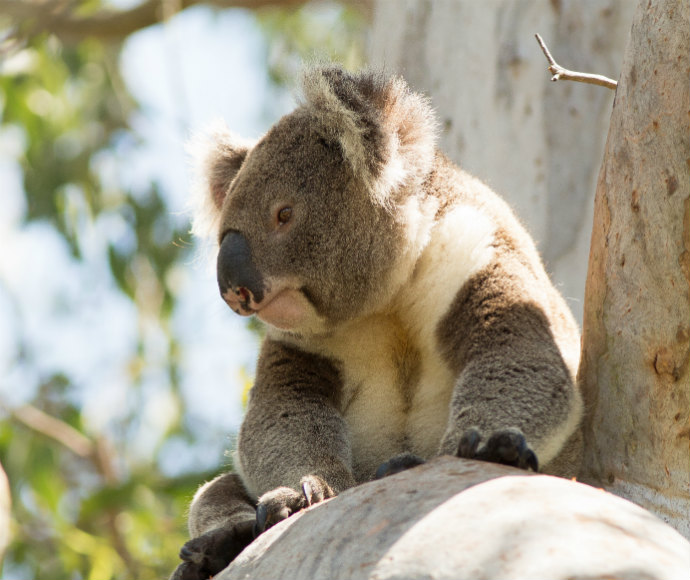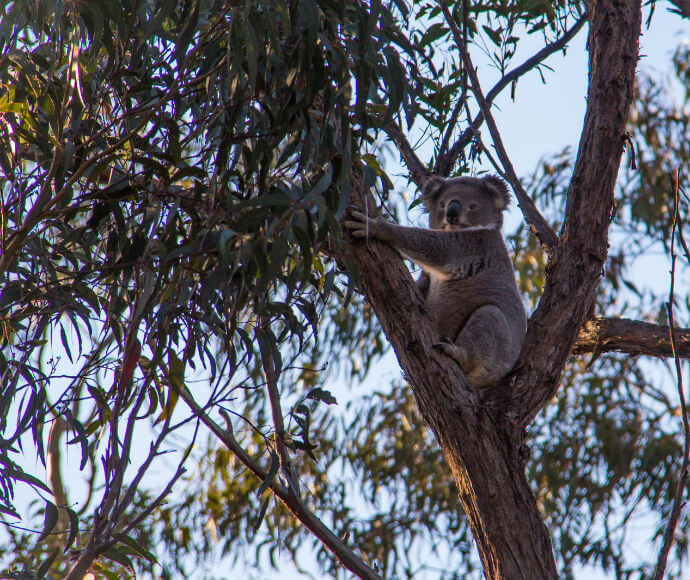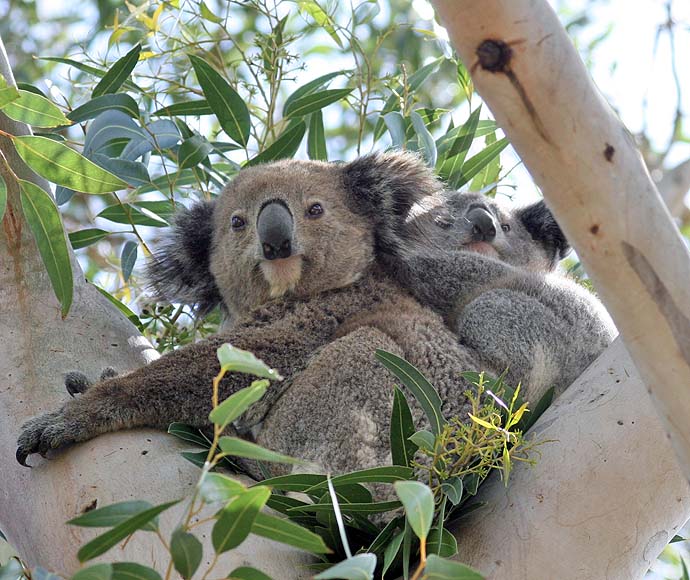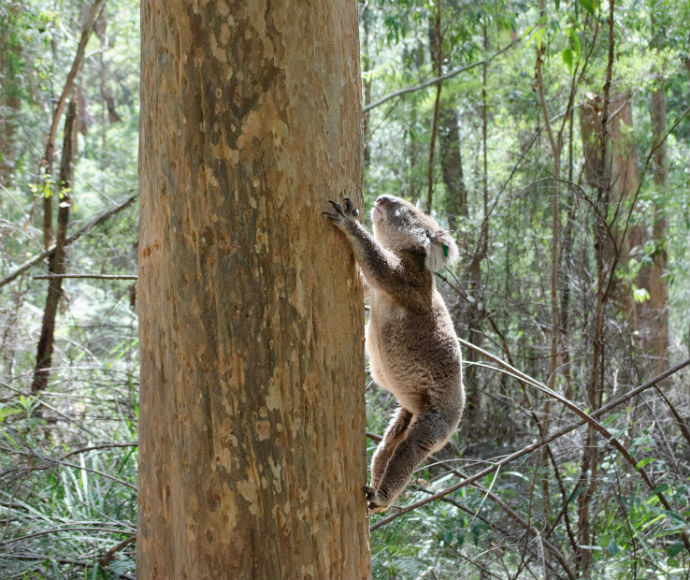What do they look like?
The koala is a tree-dwelling marsupial with large furry ears, a prominent black nose, long sharp claws adapted for climbing and no tail. Fur colour varies from pale grey in north Australia to grey-brown in the south.
Koalas also vary in size across their range. Adult males weigh between 4 and 14 kilograms and adult females weigh between 4 and 10 kilograms.
Despite being called 'koala bears' for many years, koalas are marsupials. While bears give birth to well-developed young, newborn koalas are tiny enough to fit on your thumbnail and are raised in their mother's pouch.
The closest relative of the koala is the wombat. Both animals have pouches which open towards the rear. This is fine for the wombat, but koalas need strong muscles ringing the pouch to keep their young from falling out.
Why are they special?
- Koalas are one of Australia's most iconic animals, recognisable around the world.
- People have a close affinity with the koala.
- Koalas feature in many Aboriginal dreaming and creation stories and are a totemic species.
- Koalas benefit the Australian economy. It has been estimated that they create over 9,000 jobs and contribute between $1.1 billion and $2.5 billion per year to tourism in Australia.
- Although the koala’s scientific name, Phascolarctos cinereus, means ‘ash-coloured pouched bear,’ the koala is not a bear but a marsupial whose closest relative is the wombat.
- Koalas feed almost exclusively on eucalyptus leaves. The 2 or 3 primary tree species they prefer vary throughout their range. See the recent review of koala tree use across New South Wales.
Go to NSW Koala Country to find out how you can help koalas.
What do they sound like?
During breeding, males advertise with loud snarling coughs and bellows. Koala mating songs range from the pig-like grunts and growls of the males, to the high-pitched sounds of the females.
Research published in the Journal of Experimental Biology and publicised by ABC Science indicates there is a variation in the bellows that correlates with the size of the male – this may be used to intimidate rivals or attract mates.
Where do they live?
Koalas live in eucalypt woodlands and forests. Home range size varies according to quality of habitat, ranging from less than 2 hectares to several hundred hectares.
Koalas are found between south-eastern South Australia and Queensland. The largest koalas weigh over 10 kilograms and are found in Victoria, while the smallest live in North Queensland and weigh only 5.5 kilograms.
In New South Wales, koalas mainly live on the central and north coasts, with some populations west of the Great Dividing Range, on the south coast and on the southern tablelands. Most populations live in isolated habitats and many areas in which koalas are most abundant are subject to intense pressures.
What do they eat?
A koala eats about half a kilogram of leaves each day. Koalas are fussy eaters, choosing most of their food from a few varieties of eucalypt. Around Sydney, red gums and mahoganies are their favourites. In northern areas of the state, tallowwood and forest red gum are important, manna gum tops the bill in the south, and in the west koalas prefer river red gum and ribbon gum. They use a variety of other trees for shelter during the day and in heatwaves or storms, including paperbark, she-oak, brush box and acacia trees.
Gum leaves are not the easiest things to digest – they are tough and contain oils which can be poisonous. To cope with such an unusual diet, koalas have a long, thin tube like an appendix branching out from their intestines. This tube grows to a length of 2 metres. It probably helps with digestion, although its exact function remains a mystery.
As their food contains little energy, koalas conserve energy by sleeping for most of the day and looking for food in the evening. Koalas do not normally drink water, as they get enough water by licking the dew from leaves.
How do they get around?
With huge claws and strong muscles, koalas are able to hold on tightly to trees. They have 2 thumbs and 3 fingers on each front paw, which makes their grip more even on each side of a branch. They also have a clawless big toe on their hind legs, which allows them to grip with their hind feet as well.
Two of their hind toes joined together form a handy two-toothed comb, used for grooming fur and removing ticks.
Breeding and life cycle
Koalas live for between 10 and 20 years, and generally breed between September and February. Female koalas can breed from about 2 years of age and have a gestation period of about 2 months, producing one koala a year. On rare occasions they may produce twins.
A newborn koala is tiny, blind and hairless. Dragging itself into its mother's pouch, it attaches itself to one of her 2 teats. By about 7 months, the baby has outgrown the pouch. It rides on its mother's back, or rests against her chest as she drowses in the fork of a tree. During this time, the young koala samples gum leaves. When the young koala is about one year old, its mother is able to mate again.
Often, young male koalas will be driven off by older males. To survive, they must find a suitable area which is not already occupied by other dominant male koalas. Koalas are generally solitary, although they do have a social structure based on a dominant male. They rest for most of the day. At night, they feed and move between trees and sometimes along the ground.
Status
The koala has suffered a dramatic decline in numbers and distribution since the arrival of Europeans. Surveys in New South Wales indicate that, since 1949, populations of koalas have been lost from many localities. Most populations in New South Wales now survive in fragmented and isolated habitat and many of the areas in which koalas are most abundant are subject to intense and ongoing pressures.
The koala is listed as 'vulnerable to extinction' under the Biodiversity Conservation Act 2016 because of declining numbers and the ongoing pressure of threats. Such a listing gives the species more protection and attention, and means proposals for development that will affect koala habitat are rigorously assessed.
In April 2012, koala populations in Queensland, New South Wales and the Australian Capital Territory were listed as vulnerable to extinction under the Commonwealth Environment Protection and Biodiversity Conservation Act 1999.
Threats
Threats to koalas include:
- loss, modification and fragmentation of habitat
- disease (chlamydia)
- vehicle strike
- intense prescribed burns or wildfires that scorch or burn the tree canopy
- predation by roaming or domestic dogs
- heat stress through drought and heatwaves
- human-induced climate change.
Chlamydia in koala populations
The most significant disease in koala populations is chlamydia, a highly infectious bacterial disease. Koalas in New South Wales carry chlamydia pathogens but do not always show clinical signs of disease. They have symptoms such as conjunctivitis and urogenital tract infections when they are stressed by:
- loss of habitat
- harassment by predators
- starvation or malnutrition
- overcrowding.
The disease weakens koalas, making them more vulnerable to death from other causes, particularly dog attack and severe weather conditions. Under the NSW Koala Strategy, the NSW Government is investing in research to better understand the impacts of diseases such as chlamydia on koala populations and to identify the best ways to reduce the impact. Trials are also under way in Queensland to test whether a recently developed vaccine can protect koalas from chlamydia.
As koalas generally give birth to once a year, their populations cannot increase rapidly. However, as mortality is also low, populations can double in 3 years in the absence of chlamydiaand other threats. Local extinctions are possible where:
- there is loss of fertility due to chlamydia
- there is habitat fragmentation
- there are high rates of mortality due to one or more localised threats – for example, vehicle strike in urban areas, heatwaves and fires.
Protection of native animals
All native birds, reptiles, amphibians and mammals, but not including dingoes, are protected in New South Wales by the Biodiversity Conservation Act 2016.





